| |
Arrow
Heads/Points & Native American Relics
 I'm creating these
pages as a way to catalogue my collection and learn about point typology.
It's also the place where I'll be recording the notes I take while doing
research on ancient America. These points are not for sale though I am
occasionally interested in purchasing old collections especially if they are
personal finds. Personal recollections by the finder about the finding of the
artifacts are definitely of interest to me. Many times the story is more
interesting than the point itself. I'm creating these
pages as a way to catalogue my collection and learn about point typology.
It's also the place where I'll be recording the notes I take while doing
research on ancient America. These points are not for sale though I am
occasionally interested in purchasing old collections especially if they are
personal finds. Personal recollections by the finder about the finding of the
artifacts are definitely of interest to me. Many times the story is more
interesting than the point itself.
Rob Horne

|
Axe - 3/4 Groove
Colorado
L 6.5" x W 2"
3/4 groove are deemed younger than full groove
axes and were probably associated with the late Archaic to the Woodland
periods. Celts are associated with the Woodland times through the
Mississippian. |
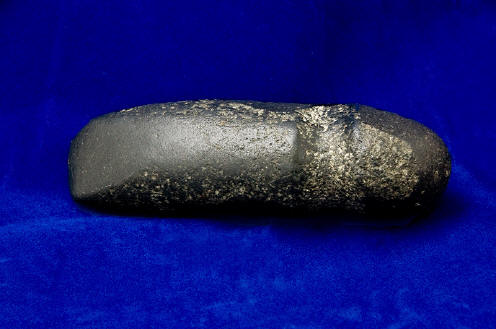
|
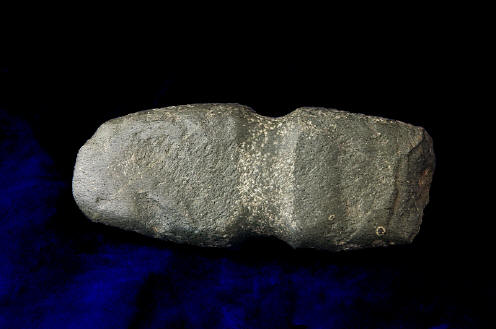 |
Axe - Full Groove
Colorado
L 5.95" x W 2.44"
Full grooved axes are supposedly the oldest
variety more associated with Archaic times. 3,000 BP to 10,500 BP. |
|
Adena Robbins
Late Archaic to Late Woodland, 3000
- 1200 B.P.
L 1.35" W .83"
2 tone tan chert
Found in Franklin County, Ohio
The Adena culture was a cluster of many Native American villages that
existed about 500-100 B.C. in the central and southern parts of Ohio. The
communities were located along the Ohio River, which made it possible for
them to travel by canoe and do a lot of trading.
The Adena culture eventually
declined and was replaced by the Hopewell culture, which lasted to around
500 A.D. |
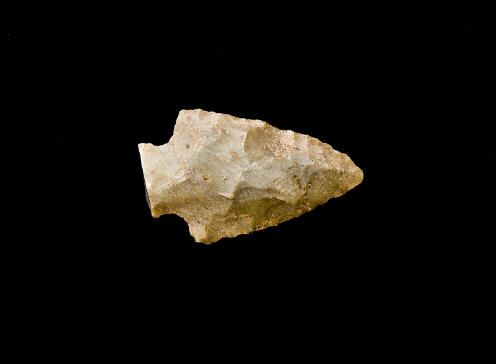 |
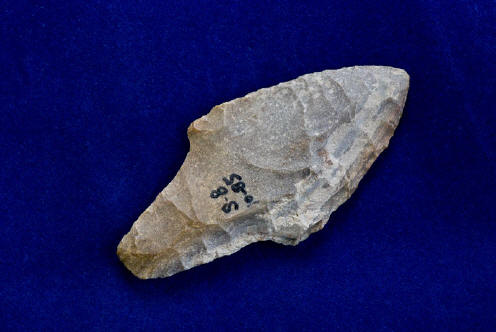 |
Adena
Late Archaic to Late Woodland, 3000
- 1200 B.P. L 2-5/8"
Eastern to Southeastern states. A
medium to large, thin, narrow to broad rounded "beaver tail" stem. Bases can
be ground. - Overstreet 10 p. 332
3 Tone Brown Chert Lafayette County, Arkansas
|
|
Adena Knife
Late Archaic to Late Woodland, 3000
- 1200 B.P.
Whiteside County Illinois
3.75" in length.
Eastern to Southeastern
states. A medium to large, thin, narrow to broad rounded "beaver tail" stem.
Bases can be ground. -
Overstreet 10 p. 332 |
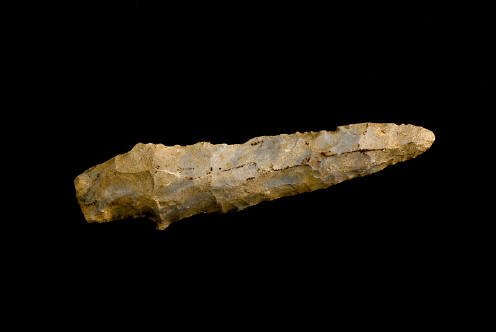 |
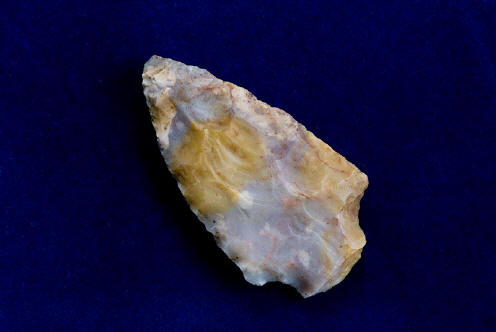 |
Adena-Snap
Base Point
Late Archaic to Late Woodland, 3000
- 1200 B.P.
Flint Ridge point from Knox
co Ohio. This point measures 2 1/4'' long by 1 1/8'' wide. This point has
some of the finest colors you will see. There are lots of purple and golden
hues. The base appears to have anciently been reworked. -
Overstreet 10 p. 332 |
|
Adena - Long Stemmed
Late Archaic to Late Woodland, 3000 - 1200 B.P.
L 2.31" W .92"
Eastern to Southeastern
states. A medium to large, thin, narrow to broad rounded "beaver tail" stem.
Bases can be ground. -
Overstreet 10 p. 332

Jackson COA
|
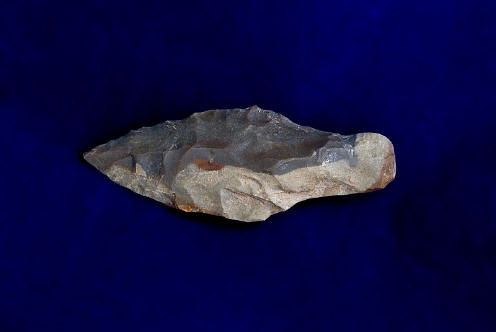 |
 |
Adena
Origin:
Carter County, Kentucky - Ex - Connelly Collection
Material: High Grade Boyle Chert
Length: 2 13/16
Width: 1 1/4"
Late Archaic to Late
Woodland, 3000 - 1200 B.P.
 Jackson COA
Eastern to Southeastern states. A medium to
large, thin, narrow to broad rounded "beaver tail" stem. Bases can be
ground. - Overstreet 10 p. 332
|
|
Anasazi/Hohokam Point
From the Sonora Desert
L 2.51" W .90"
Anasazi, Ancient
Pueblo People or Ancestral Puebloans were a prehistoric Native American
culture centered on the present-day Four Corners area of the Southwest
United States, noted for their distinctive pottery and dwelling construction
styles. Archaeologists still debate when a distinct culture emerged, but the
current consensus, based on terminology defined by the Pecos Classification,
suggests their emergence around 1200 BC, during the Basketmaker II Era.
The term Hohokam, borrowed from the Akimel O'odham, is used to define
an archaeological culture that existed from the beginning of the current era
to about the middle of the 15th century AD. As an abstract construct this
culture was centered on the middle Gila River and lower Salt River
drainages, in what is known as the Phoenix basin.
While the names
Anasazi/Hohokam sell better on Ebay, I would be more likely to label this a
San Pedro or variant of some sort.
Overstreet 10 p.877.
Actually I don't see any listed for this area that closely resemble this
point.
|
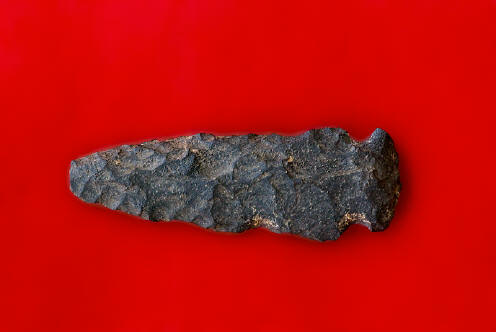 |
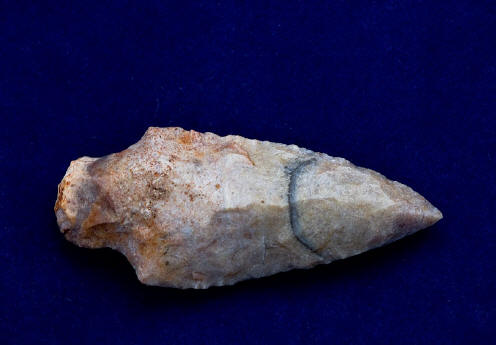 |
Beacon Island Point, Tennessee
Late Archaic, 4000 - 3000 B.P.
L 2.13" W .90"
Gray and light brown chert.
Found in Sumner County,
Tennessee
Southeastern States. A small
to large size triangular point with a bulbous stem. Shoulders are usually
well defined and can be barbed. - Overstreet 10 p.343
|
Beaver Lake
Paleo, 11,250 - 8000 B.P.
Barren County Kentucky
L 2" W 3/4"
Sonora Hornstone
Southeastern states. A medium to large size
lanceolate blade with flaring ears and a concave base. Contemporaneous and
associated with Cumberland but thinner and un-fluted. Has been found in
deeper layers than Dalton.
Overstreet 10 p.344
|
 |
|

|
Beekman Triangular
Late to Terminal Archaic, 4800 - 4500 B.P.
L .78" W .73" Quartz
Found in a garden in Charlestown R.I.
Northern Pennsylvania into New York, New
Jersey and Massachusetts. A small size, short, triangular point with a
broad, straight to concave base. Bases are ground. -
Overstreet 10 p. 113 |

| |
|
Useful
Resources
|
|
|

Authentic
Artifact
Collectors
Association
______
Overstreetid.com
The Official Overstreet Indian
Arrowhead Identification Online Database
______
|
|
|
|
|
|
|